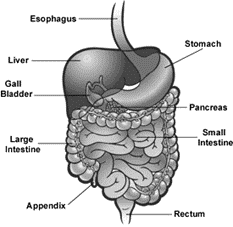Digestive problems can cause many unpleasant symptoms. A healthy digestive system is important to our quality of life, and there are many things we can do to support digestive function.
The foods we eat are a key factor in the digestion process, although they are not the only influence. A balanced diet suited to your individual body will promote nutrient absorption, support a healthy gut micro-biome and encourage efficient waste elimination. We can also influence the digestive system by stimulating activity in the digestive organs, and by soothing the nervous system into a digestion-promoting state with practices like yoga.
Yoga for digestion can be beneficial alone or in combination with other treatments. Below, we discuss the benefits of yoga for digestion and 8 effective poses you can do to stimulate the digestive system and bolster gut health.
Digestion Explained
What Is Digestion?
Digestion is the process our body uses to break food down into small water-soluble molecules that can be absorbed into the bloodstream. The substances we absorb from our food include vitamins, minerals, fats, carbohydrates and proteins. These are used by our body for energy, growth and repair.

Human digestive system
Where Does Digestion Begin?
The process of digestion starts at the mouth. Food is broken down through chewing and the digestive enzymes in saliva. From the stomach, food is squeezed into the small intestine. There, digestive enzymes from the pancreas and bile from the liver and gall bladder neutralize the stomach acid and continue to break down the food. As the food passes through the lower end of the small intestine, the nutrients are absorbed through the lining of the intestine and into a fine mesh of tiny blood vessels. What’s left of the food passes into the large intestine, also called the bowel, where only water is absorbed from it.
What Are Symptoms of Digestive Problems?
Problems arising from the digestive system range from gas to more distressing symptoms like:
- Nausea
- Pain
- Bloating
- Heartburn
- Indigestion
- Constipation
- Diarrhoea
- Low energy or fatigue
- Anxiety related to symptoms
- Weight management issues
If you experience severe digestive issues like the ones mentioned above, it's important that you seek medical advice from trained medical professional before attempting to treat the issue yourself.
How Yoga Helps Digestion
Yoga can help soothe general symptoms of digestion such as gas, constipation and bloating. Furthermore, yoga’s ability to calm the nervous system and promote relaxation has been shown to relieve more severe digestive issues like irritable bowel syndrome (IBS). Alongside medical treatment, practicing yoga for digestion can boost your health and well-being in the following ways:
1. Stimulates the digestive organs
Some yoga asanas apply pressure or compression on the digestive organs; others apply a stretch. These changes in pressure improve circulation, bringing an increased flow of fresh blood to the organs to enhance their natural function.
Additionally, these movements work to move food efficiently through the digestive tract. Twisting poses are often used with this intent, moving food along to relieve constipation.
Movement of the diaphragm during breathing exercises also helps massage and mobilize the digestive organs.
2. Improves gut health
Yoga inversions are a great tool for improving your gut health. When in an inverted position, the weight from other organs is removed from the bowel. This change may allow waste products to move more freely along the tract. Yoga inversions for digestion include poses that invert the torso rather than just the legs, such as Headstand and Shoulderstand.
3. Balances the Manipura Chakra
We experience our greatest health and well-being when energy flows in a balanced way through each of the seven major chakras.
The chakra related to digestion is the Manipura Chakra, often referred to as the Solar Plexus Chakra. If the Manipura energy centre is blocked or out of alignment, digestive effects can include constipation, irritable bowel symptoms, poor absorption of nutrients, stomach ulcers and colonic issues.
There are several yoga poses you can practice to activate the Solar Plexus Chakra, these include Seated Forward Bend, Upward Plank Pose, Cobra Pose, Locust Pose, and Half Spinal Twist.

Get a free copy of our Amazon bestselling book directly into your inbox!
Learn how to practice, modify and sequence 250+ yoga postures according to ancient Hatha Yoga principles.
4. Soothes the Nervous System
Our brain and nervous system control not only the movements we choose to make, but also the internal processes we don’t consciously control. The part of the nervous system most relevant to improving digestion is the parasympathetic nervous system. This network of nerves regulates the “rest and digest” responses such as reducing heart rate and blood pressure, and promoting digestion.
When we are threatened or stressed, the “rest and digest” responses are outweighed by the “flight or fight” responses which reduce all the digestive processes to prepare you for urgent action.
For digestive health, it’s important to ensure you regularly take steps to manage your stress levels and intentionally relax so your parasympathetic nervous system can take over and promote digestion. Yoga offers many relaxation practices including breathing exercises, meditation, and relaxing postures.
5. Promotes Healthier Habits
The philosophy of yoga addresses a very important digestive issue: food choices. Through the Yama and Niyama (our character and habits) we are encouraged to make choices that are good for our health and wellbeing.
Ayurveda is a holistic health system that is focused on balancing the primal elements of the body, maintaining good health and preventing illness. Inefficient digestion is recognized as a cause of many physical health issues, and Ayurveda offers dietary practices to relieve and prevent these issues. We suggest Ayurveda as a useful addition to yoga for digestion. You can find an introduction to Ayurveda on our blog.
8 Yoga Poses to Boost Digestion & Gut Health
1. Headstand

Headstand (Shirshasana)
Headstand, also called Shirshasana, is an inversion that activates the parasympathetic “rest and digest” mode (as long as the pose is comfortable and not stressful for you). This promotes digestion and hormonal balance and releases the gravitational compression of the colon.
2. Plough Pose

Plough Pose (Halasana)
Plough Pose, or Halasana, is another inversion that activates the rest and digest mode and releases the pressure of gravity on the colon. It also creates compression to massage the visceral organs. When the compression is released, the organs will flood with new blood.
3. Frog Pose

Frog Pose (Mandukasana)
Frog Pose, also known as Mandukasana, uses compression to stimulate the digestive system. It is practiced by kneeling, sitting on the heels, and placing the clenched fists where the abdomen meets the thighs. Move into the pose by breathing in to open the chest, breathing out, and folding forward to rest the forehead on the floor.
4. Seated Forward Bend

Seated Forward Bend (Paschimotthasana)
Seated Forward Bend, also called Paschimotthasana, is a rejuvenating seated pose that stimulates the digestive tract through the squeeze-and-release effect. This motion improves digestion, eliminates toxins, and combats constipation.
5. Classical Cobra Pose

Cobra Pose (Bhujangasana)
Classical Cobra Pose, or Bhujangasana, is an effective pose to stimulate the digestive system both by pressure on the abdominal organs and by stimulating the Manipura Chakra to balance the functions of the digestive organs. It may stimulate the contractions of the intestines and therefore relieve constipation.
6. Bow Pose

Bow Pose (Dhanurasana)
Also known as Dhanurasana, Bow Pose is an intensive exercise that tones and strengthens the digestive organs through abdominal pressure. This pose also activates the Solar Plexus Chakra, balancing the functioning of the entire digestive system.
7. Half Spinal Twist

Half Spinal Twist (Ardha Matsyendrasana)
Half Spinal Twist, also called Ardha Matsyendrasana, is another pose that combines stimulation of the Manipura Chakra with massage and compression of the digestive tract and organs. Many people feel comfortable holding this pose for several breaths, or for a couple of minutes, making it particularly effective for beginners or practitioners with mobility issues.
8. Corpse Pose

Corpse Pose (Shavasana)
Also referred to as Shavasana, Corpse Pose is a relaxing yoga pose for digestion, often practiced at the beginning or end of a practice. Corpse Pose soothes the nervous system into parasympathetic activation which aids the digestive process and promotes a healthier and happier gut.
Final Thought
A holistic approach to health allows us to see that our bodies and wellbeing are intrinsically connected. Our digestive health influences and is influenced by our physical, mental and emotional health. Our diet, stress management and daily habits play a significant role in maintaining our holistic health.
Yoga, and also the allied health science of Ayurveda, can influence our digestive health by all of these pathways. Yoga for digestion can also help balance our astral or energy body to prevent physical issues arising. Adding some of these poses to your regular yoga practice will improve your digestive functioning for a happier and healthier gut.

Get a free copy of our Amazon bestselling book directly into your inbox!
Learn how to practice, modify and sequence 250+ yoga postures according to ancient Hatha Yoga principles.

